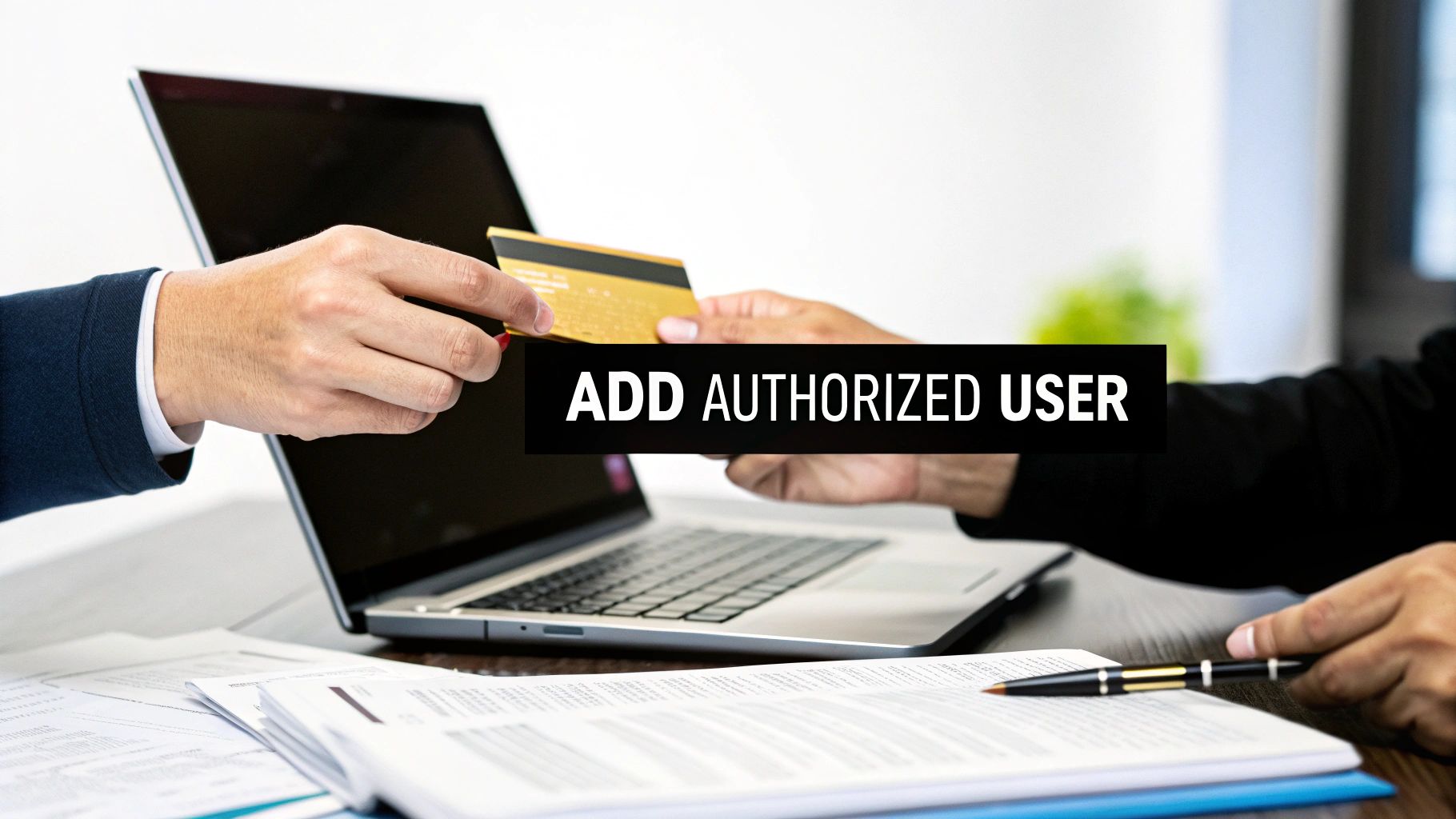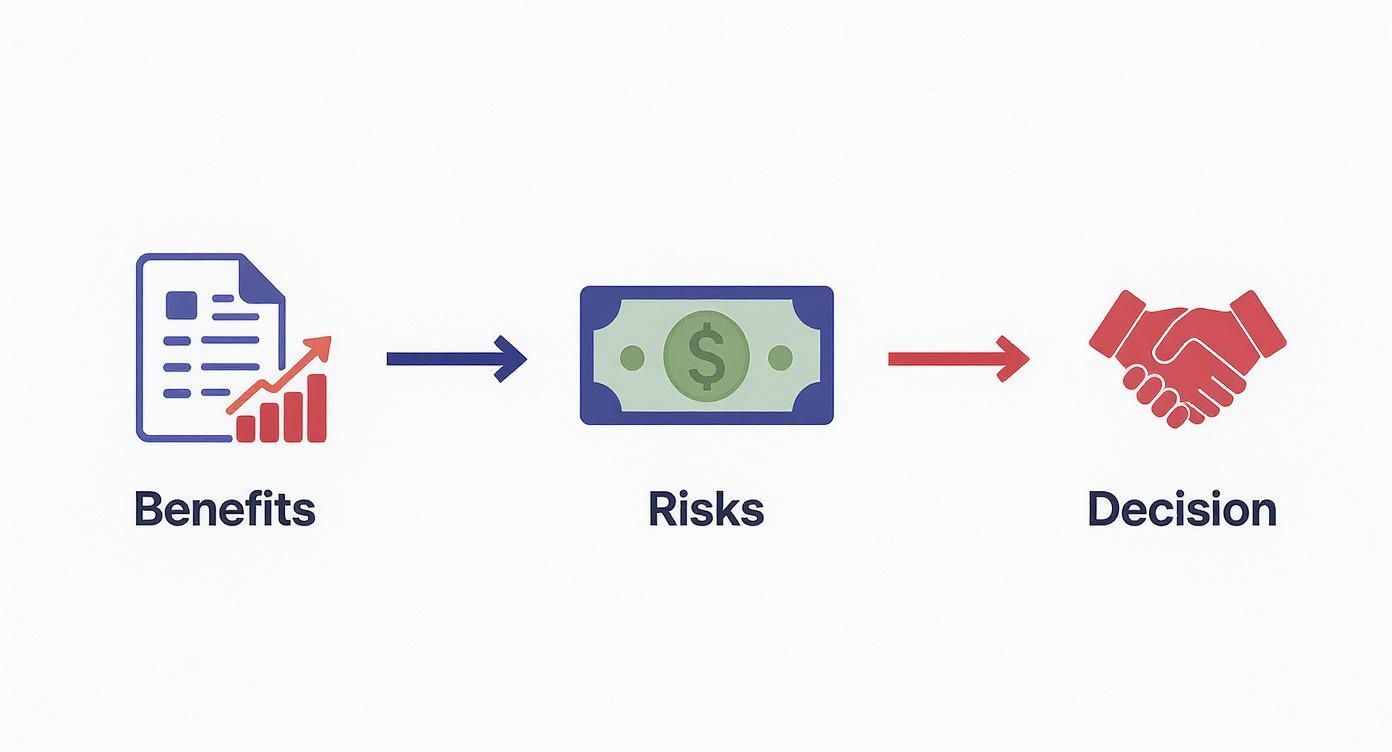Adding an Authorized User to Build Credit with an ITIN

One of the smartest moves you can make to help a family member with an ITIN is to add them as an authorized user on one of your credit cards. Think of it as giving them a leg up, letting them benefit from your good credit history to build their own foundation in the U.S. financial system.
This strategy, often called "piggybacking," lets your responsible credit habits give them a serious head start.
A Practical Tool for Building a Financial Future

For anyone with an ITIN, getting started in the American financial world can be a real challenge. Adding a trusted person as an authorized user is one of the quickest ways to accelerate their credit-building journey, helping them establish a profile much faster than going it alone.
Essentially, you're sharing your financial reputation. When you add them, the entire account history—your on-time payments, the age of the account, the credit limit—can show up on their credit report. This shared account is what's known as a tradeline. If you want to dive deeper, you can learn more about how credit report tradelines work in our detailed guide.
For the new authorized user, the benefits are immediate and impactful:
At the end of the day, this isn't just a simple financial favor. It's a team effort to create a more secure financial future for the people you care about. When you understand the upsides and your own responsibilities, you can use this strategy to truly empower your family members on their path to financial independence.
Weighing the Benefits and Responsibilities
Bringing someone on as an authorized user to your credit account is a big decision. It’s a mix of real opportunity for them and significant responsibility for you. On the plus side, you're giving someone a huge leg up in building their financial future. Your track record of paying on time and keeping balances low can start showing up on their credit report, giving them a solid foundation.
Think about a spouse who just arrived in the U.S. and has an ITIN. By adding them to your card, you could shave months—or even years—off the time it takes for them to qualify for their own car loan or get approved for an apartment. It's not just about credit building, either. There are everyday advantages, like combining rewards points to hit a shared goal faster, whether that's a family vacation or a new refrigerator.
Understanding the Financial Risks
While the benefits are clear, you can't ignore the risks. As the primary cardholder, you are 100% legally responsible for the entire balance. It doesn't matter who made the purchase; the bank will come to you for payment.
This is where trust is non-negotiable. Before you even think about adding someone, you need to sit down and have a frank conversation about money. Talk about spending limits, what the card should be used for, and how they'll pay you back for their charges.
A Common Practice with Big Implications
Adding an authorized user is incredibly popular, especially for families and couples trying to simplify their finances. It’s a standard financial tool used all over the world. With 2.8 billion credit cards out there globally, it's just a normal part of how households manage their money.
Just look at Canada, where 82.7% of adults have a credit card. Sharing accounts is a routine way to combine spending power and get the most out of rewards programs. You can find more details on global credit card usage at Spendesk.com.
Ultimately, this arrangement works best when it's a true partnership built on trust and open communication. It can be a powerful way to lift someone up financially, but it all starts with recognizing that the risk is entirely on your shoulders.
How to Add an Authorized User to Your Account
Ready to get started? The good news is that adding an authorized user is usually a straightforward process. Most credit card companies have made it pretty simple, letting you get it done in a few minutes online, through their mobile app, or even with a quick phone call.
First things first, you'll need a few pieces of information from the person you want to add. Make sure you have their details on hand to keep things moving smoothly.
You'll need their:
Having this ready to go from the start will save you a lot of hassle.
Navigating the Online Process
For most people, the quickest route is through your online banking portal. Once you log in, look for an option like "Account Services" or "Card Management." From there, you should see a link to "Add an Authorized User." The on-screen form is typically very clear and will ask for the details we just covered.
This infographic can help you walk through the decision-making process, weighing the pros and cons before you commit.

It really boils down to balancing the fantastic credit-building opportunity for your family member against the financial responsibility you're taking on.
If a lender only reports to one or two bureaus, the positive impact gets watered down. A quick call to customer service is all it takes to find out their reporting policy.
Once you’ve added them, a new card with their name on it should show up in the mail within 7-10 business days. From there, it's a great idea to keep an eye on their credit-building progress.
You can use a platform like itinscore, which is built specifically for ITIN holders, to see the results in real-time. The dashboard will show your authorized user exactly when the new account pops up on their report, giving you concrete proof that your plan is working.
Comparing Issuer Policies for ITIN Holders
When you're ready to add someone as an authorized user, you'll quickly find that not every credit card issuer plays by the same rules—especially when an ITIN is involved. One bank might make it incredibly simple, while another has frustrating requirements that can stop you in your tracks.
Doing a little homework upfront is the key. You want to make sure the time and trust you're investing will actually pay off for the person you're trying to help.
What to Ask Your Bank Before Adding a User
The most important question is whether the issuer reports the authorized user's account activity to all three major credit bureaus: Experian, Equifax, and TransUnion. If they only report to one or two (or none!), the credit-building benefit is seriously diminished.
Before you make the call, have these questions ready:
Sharing credit is a common financial tool in the U.S., where 66.7% of adults have at least one credit card. It’s a stark contrast to many countries where credit card ownership is below 10%. You can see just how much credit card ownership varies globally on TheGlobalEconomy.com.
ITIN Authorized User Policies of Major U.S. Banks
To give you a head start, I've put together a quick comparison of what you can expect from some of the major ITIN-friendly banks. Policies can change, so it's always smart to call and confirm yourself, but this table is a great starting point.
This comparison shows why a little research is so valuable. For example, Capital One makes it easy to add someone without their ITIN initially, while Chase requires it from the get-go.
For a deeper dive, our guide on the best credit cards for ITIN holders breaks down which banks are the most welcoming and which cards offer the best features for building credit this way. It'll save you a ton of time and help you pick the right card from day one.
Tracking Their Credit Building Progress
So, you've added them as an authorized user. What's next? This is where the magic really happens—watching their credit profile begin to take shape. You've done the work, and now it's time to see the results.
Don't expect to see changes overnight. It usually takes about one to two billing cycles for your account to pop up on their credit report. A little patience goes a long way here. Once it does, it can give their credit a serious boost by essentially "lending" them your good history.
What to Look For on Their Credit Report
For an ITIN holder just starting out, seeing a new account on their credit report is a huge win. The best way for them to keep an eye on this is by using a tool built for them. Your authorized user can sign up for a service like itinscore to get a clear, detailed look at their credit file.
Once they log in and see your account, here’s what they should be checking for:

This whole strategy is a cornerstone of the U.S. credit system, where over a billion credit cards are in circulation. It's interesting when you look at the global picture; debit cards are actually far more common, with 52.8% of consumers holding one, versus just 24.5% with credit cards. You can dig into more global credit card ownership trends on CardRates.com. This really drives home why the authorized user strategy is such a uniquely powerful tool within the American financial landscape.
By regularly checking their progress, both of you can make sure the account is being reported correctly and celebrate the milestones. If you want to learn more about the tools available, our guide on free credit monitoring for ITIN holders is a great place to start. This follow-through is what turns a simple favor into a real, measurable success story.
Still Have Questions About Authorized Users? Let's Clear Them Up
Even after you've decided to add an authorized user, it's natural to have a few lingering questions. Based on my experience helping ITIN holders navigate this process, these are the most common concerns that come up. Let's get them answered so you can move forward with total confidence.
Will Adding an Authorized User Hurt My Credit?
This is probably the number one question I get, and the short answer is no—the act of adding them won't drop your score.
However, their spending is now your spending in the eyes of the credit bureaus. If they run up a high balance and push your credit utilization ratio above 30%, your score could take a hit. This is exactly why you should only add someone you trust completely to be responsible.
Can I Put a Spending Cap on Their Card?
That's a smart question, but the answer really depends on your credit card issuer. Some banks are great about this. American Express, for example, gives primary cardholders the ability to set specific spending limits for each authorized user, which is a fantastic feature for controlling the account.
Many other banks don't offer this, meaning the user gets full access to your credit line. Before you do anything, call the number on the back of your card and ask what tools they provide for managing authorized user spending.
Does My Authorized User Need to Have an ITIN?
If your goal is to help them build credit, then yes, they absolutely do.
Most major banks require either an SSN or an ITIN to report the account's payment history to the credit bureaus (Equifax, Experian, and TransUnion). You might be able to add someone without one, but they won't get any of the credit-building benefits, which is the whole point for many families. Always double-check this requirement with your bank.
Ready to watch your family's credit-building efforts pay off in real-time? itinscore offers free, unlimited credit monitoring designed specifically for the ITIN community. You can sign up in minutes and get a clear view of your financial health today.